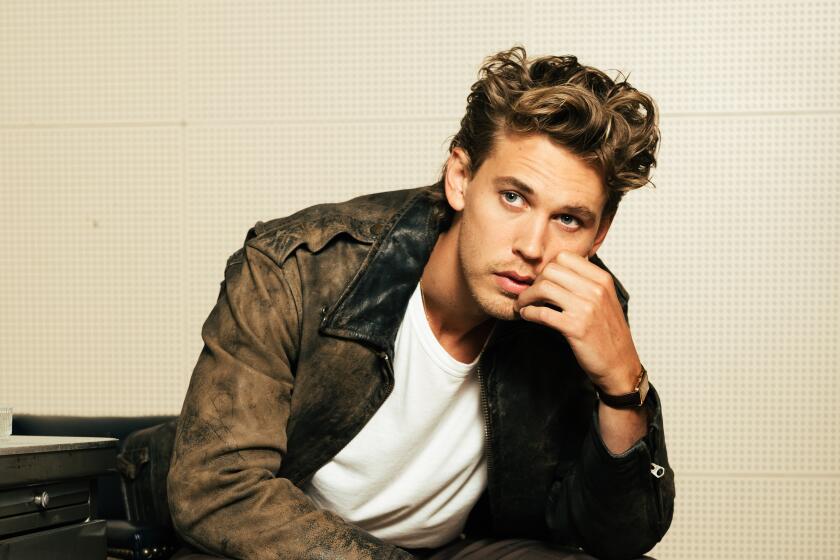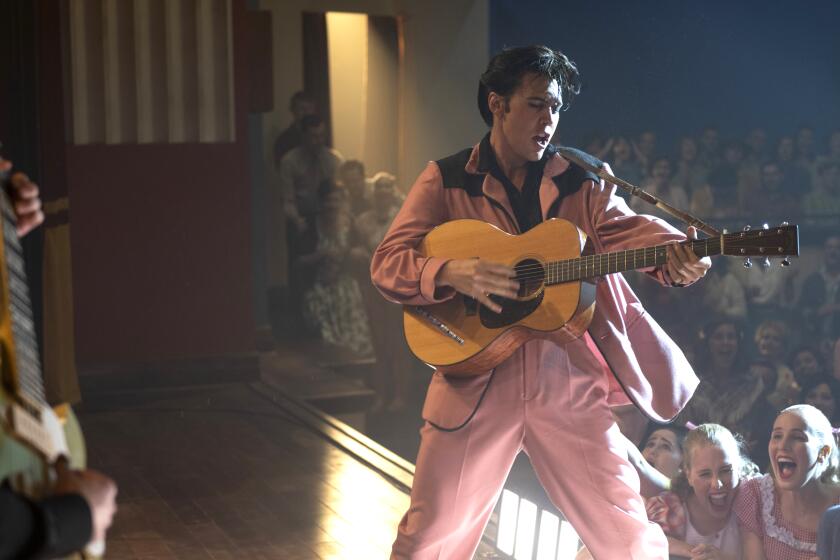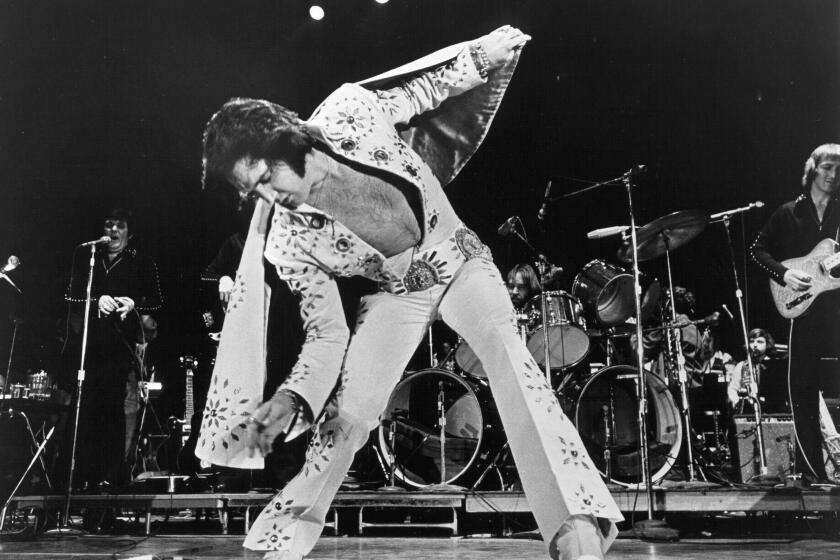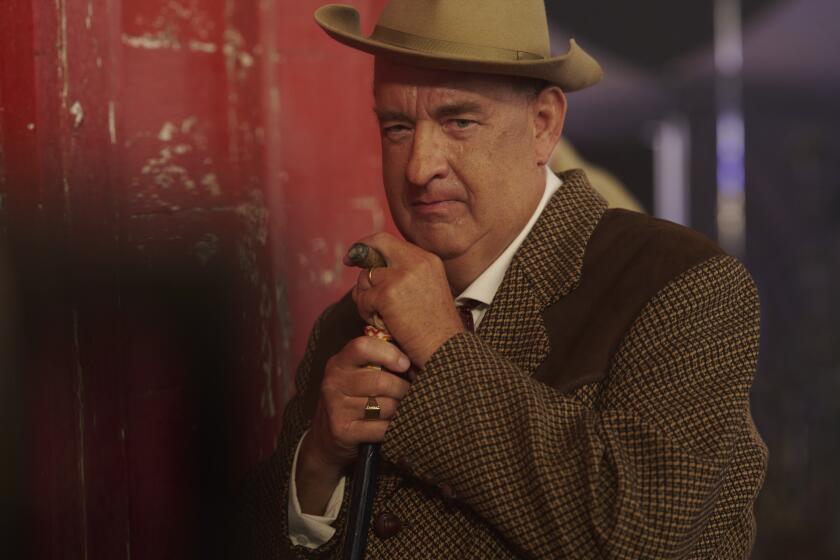How ‘Elvis’ re-creates Elvis Presley’s haunting 1977 performance of ‘Unchained Melody’
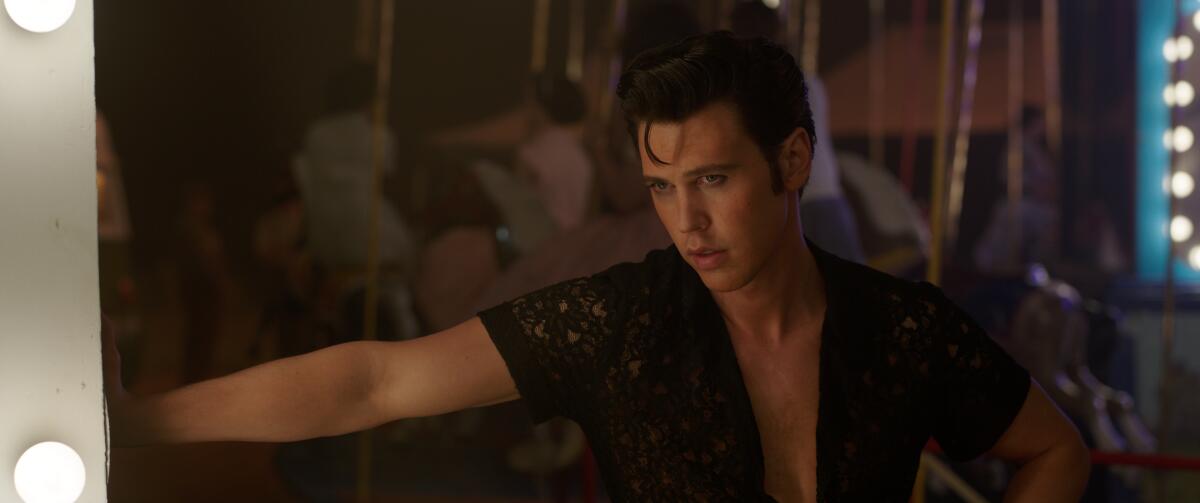
- Share via
Austin Butler threw his voice, body and soul into playing Elvis Presley in Baz Luhrmann’s grandiose musical drama “Elvis,” even recording his own versions of the rock ‘n’ roll icon’s hip-swiveling, live-wire early songs. But to bring the big-budget epic to its showstopping close, Luhrmann and Butler painstakingly re-created one of Presley’s most famous and heart-rending live performances: “Unchained Melody.”
The year was 1977. Presley, his body visibly suffering from years of drug abuse and deteriorating health, took the stage in his iconic bejeweled white jumpsuit for a concert in Rapid City, S.D.
Two months later he would die at 42 at home at Graceland. But on this night he wanted to play his stripped-down version of the Righteous Brothers ballad, which he had recently recorded. It would hit the charts posthumously a year after his death, leaving a mournful grace note on his legendary career.
Butler, of course, knew the tune well — he’d sent in an audition tape of himself at home performing his own tender take on the Elvis classic. He’d become a meticulous student of all things Elvis to prepare for the role, poring over archival performances and interviews to get the King’s every move and mannerism down pat.
Austin Butler poured everything he had into playing Elvis. The actor shares the grief, music and obsessive research that went into his portrayal.
For most of “Elvis,” however, Butler uses that research as a foundation to slip into character and to be able to walk, talk, dance, sing, improvise and emote as his own interpretation of Presley — what Luhrmann describes as a “mixture of Austin and Elvis’ spirits.” When it came to re-creating certain performances, Luhrmann called “trainspotting” moments — the beloved numbers hardcore Elvis fans know every detail of, inside and out — the pressure ramped up.
Footage of Presley’s 1977 “Unchained Melody” performance has been viewed millions of times via YouTube, for example. “Somebody is going to know exactly how he placed his foot, how he placed his hand or how he sang this song,” said Butler.
In it, Elvis offers a rambling introduction, then walks over to sit at a piano littered with Coca-Cola cups. Friend and backup singer Charlie Hodge holds a mic. Then, pounding furiously on the piano keys, a sweat-glistened Presley wails out the song — which Butler did too, playing and singing to playback under prosthetics and layers of costuming.
“‘Unchained Melody’ was a physical challenge because it was done with the jumpsuit and the body adjustment suit under that, and it squeezes your ribs to the point where you can’t breathe,” said Butler. “I felt very claustrophobic there and very constricted, I couldn’t breathe and I was really, really hot.”
Baz Luhrmann’s erotically charged biopic “Elvis” doesn’t just reinvigorate the Presley myth, it resurrects the King and makes him relevant again.
But he was also moved by the uncanny power that Elvis taps into in the original performance. “If you watch that video, you’ll see that he gets half a sentence out and has to take a breath,” said Butler. “When he sings he belts it out, and it’s like you wouldn’t even know.”
“I remember seeing the video and thinking, ‘Oh, gosh. After that moment, what else is there?’” said Luhrmann, whose idea to use the actual 1977 Elvis tape onscreen was initially met with resistance. “There was a lot of, ‘Oh, no, we’d never do that — we don’t like seeing Elvis like that. But the moment he looks at the camera and smiles, he’s like a kid inside when he sings. It makes the point of the whole movie, which is that when he’s in front of an audience, the spirit is so alive.”
As with other iconic Elvis performances re-created throughout the film — including his 1968 Comeback Special and Las Vegas show — Luhrmann and cinematographer Mandy Walker matched lighting, lenses and camera moves to their reference footage and then unleashed Butler as Elvis.
The actor has played music for years but “it’s always been just for me,” he says. Still, Luhrmann knew he’d be throwing curveballs at his star. Filming a Vegas sequence in which Elvis directs an orchestra in a new arrangement of his 1954 hit “That’s All Right,” Luhrmann nixed the playback they’d been rehearsing with for six months when the scene wasn’t quite working.
Baz Luhrmann’s splashy “Elvis” biopic attempts to make the King relevant to a new generation. But 50 years after Presley’s last Top 10 hit, is it too late?
“I said, ‘I think you have to go for real, so we’ll just unmute all the instruments and you just be Elvis and make it up: You hear the music, you know the orchestrations,’” said Luhrmann. “That’s what Elvis did. And Austin never shows fear, but I’ve never seen him more scared. He was absolutely white as a sheet and trembling in the corner. [But] what’s in the movie is basically a couple of takes. He just made it up ... and I know from testing that it’s one of the favorite scenes in the film.”
By that time, Butler had already faced the most daunting day of the shoot: Re-creating the ’68 Comeback Special with 300 extras while wearing a black leather suit. Not only is it one of Presley’s most iconic live performances, it was also Butler’s first time performing as Elvis performing in the movie.
“It felt like this make-or-break moment in my life, but it was also a make-or-break moment in Elvis’ life; his career was on the line,” said Butler. “So I just accepted that the fear is going to be there, because I care so much. But if I just channeled this into the music and into building rapport with the audience, then that’s what he would have been doing.”
“I went out there and completely had an out-of-body experience,” he said. “And it turned out to be one of my most favorite days.”
Over-the-top villainy has never come easily to Tom Hanks. But in his best recent roles, he’s deftly revealed the complexities of heroism.
More to Read
Only good movies
Get the Indie Focus newsletter, Mark Olsen's weekly guide to the world of cinema.
You may occasionally receive promotional content from the Los Angeles Times.
